Intentar ORO - Gratis
Raising gilts and sows: Part 3
Farmer's Weekly
|16 June 2023
The first month after mating is a critical time during production. Stress or incorrect nutrition at this stage may lead to the deaths of embryos.
-

The sow or gilt should be mated twice, 12 to 18 hours apart, and the second service date recorded, say Graeme Taylor and Greg Roese, livestock officers at The Pig Site (thepigsite.com).
They add that during the interval, she should be returned to a pen or stall on her own. If she has to be returned to a group of sows, this should only be done after she has gone off heat. Check the sow 18 to 23 days after mating to check for any signs of a return to oestrus.
FEEDING REGIMEN
Sows
The feeding programme will not only affect the sow’s performance in that particular pregnancy; it will affect her future performance as a breeder, say Taylor and Roese.
The feeding rate is determined by body weight, sow condition, stage of pregnancy, housing and temperature.
Gilts
Even though the gilt is still growing, she should not be fed too much in the first month of pregnancy, as this can increase embryo mortality.
For most gilts, a rate of 1,8kg to 2,3kg feed/day will achieve the desired backfat reading of 25mm by farrowing time and a 15kg body weight increase after weaning.
The rate should be increased by 1kg to 1,5kg during the last two weeks of gestation.
“At no stage, however, should the gilt be overfed,” say Taylor and Roese. This is wasteful, and leads to difficulties at farrowing time and significant weight loss during lactation.
When it comes to second and third litters, give the sow an energy-dense diet during lactation. A lactating sow ration should provide at least 100MJ DE (digestible energy), 700g crude protein and 50g lysine a day. If a special lactating-sow ration is not available, feed a grower ration.
Esta historia es de la edición 16 June 2023 de Farmer's Weekly.
Suscríbete a Magzter GOLD para acceder a miles de historias premium seleccionadas y a más de 9000 revistas y periódicos.
¿Ya eres suscriptor? Iniciar sesión
MÁS HISTORIAS DE Farmer's Weekly

Farmer's Weekly
Pastry delights and cupcakes
The versatility of pastry in baking and cooking is best flaunted by two vastly different recipes appealing to the sweet and savoury tooth, while a novel way to bake those Christmas-themed cupcakes will also go down well.
4 mins
December 5-12, 2025
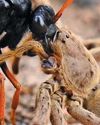
Farmer's Weekly
Specialised spider-hunting wasps
Wasps are apex predators of the insect world and have developed many survival strategies. One group of wasps focuses on hunting spiders to provide a source of food for their larval offspring
2 mins
December 5-12, 2025
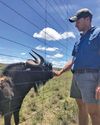
Farmer's Weekly
From bulls to boardrooms: farming part-time as a professional
Maintaining a farm requires time, resources, and commitment. Farming part-time while being fully employed elsewhere can seem daunting and risky. Although it certainly presents unique challenges, it is feasible for some. Koot Klopper and Herman van Heerden spoke to Henning Naudé about how excellent time management and the delegation of resources, as part-time farmers, successfully keep their farms productive.
5 mins
December 5-12, 2025

Farmer's Weekly
Holy Shiitake: mastering the science of gourmet fungi
Mushroom production is inherently the practice of expanding mycelium. But since wanted and unwanted fungi flourish under the same circumstances, a mushroom farmer's biggest challenge is ensuring the right fungi prevails. Lindi Botha reports on Rory Brooks' learning curve.
9 mins
December 5-12, 2025
Farmer's Weekly
No more 'secret' price hikes?
'Secret' electricity price hikes in South Africa have been curbed in a game-changing court ruling, explains Felix Dube, lecturer in the Department of Law at the University of Venda.
4 mins
December 5-12, 2025
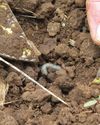
Farmer's Weekly
The cutworm scourge, and how to control it
The dominant cutworm, Agrotis segetum, is causing renewed, costly damage to South African maize, soya bean, and sunflower.
5 mins
December 5-12, 2025
Farmer's Weekly
Legislative gap requires a rethink on biosecurity controls
Since the dawn of democracy, the agriculture sector has cemented its place as one of the essential and trusted pillars for economic growth, job creation, and foreign earnings in South Africa.
2 mins
December 5-12, 2025

Farmer's Weekly
From kitchen experiments to a thriving meat empire
What started as an after-hours kitchen project in the Truter household has grown into the fully fledged meat empire Deli-Co. Brothers Pieter and Hendri Truter told Glenneis Kriel how they turned a local favourite into a multigenerational family business.
7 mins
December 5-12, 2025
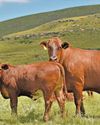
Farmer's Weekly
Brushing up on your 'cow speak'
Experienced stockman and cattle judge Willie de Jager spoke to Sabrina Dean about some of the basics of reading cattle behaviour and how best to handle these animals.
8 mins
December 5-12, 2025
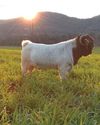
Farmer's Weekly
Corporate day job fuels farming dream
Marius Smit lives in the middle of Gauteng in Centurion and spends his workdays in the fast-paced high-stress corporate sector as a group forensic head for Discovery.
5 mins
December 5-12, 2025
Translate
Change font size
